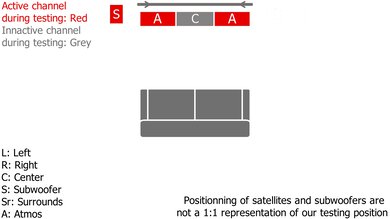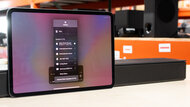The Samsung HW-Q800T soundbar is a 3.1.2 setup from Samsung's 2020 lineup. This well-built, sleek setup has two up-firing speakers integrated into the bar and a separate wireless subwoofer. It comes with Samsung's Acoustic Beam technology which uses up-firing speakers on the bar to help provide a more immersive listening experience. Its Q-Symphony feature also allows you to synchronize Samsung QLED TV speakers with the bar for a more cinematic sound, though we don't test for this currently. Amazon Alexa voice assistant support is integrated into its design, and you can even turn off the microphone when you aren't using it. Overall, its sound reproduction is very neutral and well-balanced out-of-the-box, so it's suitable for a variety of audio content. While it can play surround and Dolby Atmos content, unfortunately, it doesn't provide the most immersive listening experience. On the upside, this bar has a lot of connectivity options and sound customization features.
Our Verdict
The Samsung HW-Q800T soundbar is a versatile 3.1.2 setup that is very good for mixed usage. Its overall audio reproduction is neutral and well-balanced, making it suitable for a variety of content. It supports both Dolby Atmos and surround content, though it doesn't provide the most immersive listening experience. On the upside, there are a lot of sound customization features on the Samsung app, including a graphic EQ, presets, and a dialogue enhancement feature, so you can easily adjust the bar to meet your needs. The Adaptive Sound feature can even scan your audio content in real-time and adjust the sound the optimize your content, but we don't test for this.
- Integrated Amazon Alexa support.
- No room correction feature.
The Samsung HW-Q800T soundbar is great for TV shows. This 3.1.2 setup has a dedicated center channel, which helps make voices sound clearer and more accurate. Its sound profile is very well-balanced, especially in the mid-range, which is ideal for dialogue-heavy content. It also has a dialogue enhancement feature to help make dialogue sound more crisp. This soundbar can get loud without a lot of distortion. If you like to stream content from your mobile device to the bar wirelessly, you can use Bluetooth and Wi-Fi connections.
- Dialogue enhancement feature.
- No auto-volume feature.
The Samsung HW-Q800T soundbar is very good for music. It's neutral, balanced sound profile suits most music genres, and it can reproduce the thumps and rumbles found in bass-heavy music thanks to its wireless sub. Fortunately, there's also a graphic EQ and presets available on the Samsung app, so you can easily customize the sound to your liking.
The Samsung HW-Q800T soundbar is good for movies. It has a neutral and well-balanced sound reproduction, and it has a decent bass performance that can reproduce the thumps and rumbles from action-packed scenes and movie scores. It supports Dolby Atmos content, though it doesn't provide the most immersive listening experience. It also has to downmix surround content to stereo to play it, which doesn't sound as natural or life-like. On the upside, this bar can get loud, and there isn't a lot of distortion when you play it at max volume.
- Graphic EQ + presets.
- Poor surround and Atmos performance.
Changelog
- Updated Feb 18, 2021: Converted to Test Bench 1.0.
- Updated Sep 21, 2020: The Dynamics tests have been reconducted due to a value input bug.
- Updated Aug 20, 2020: Review published.
- Updated Aug 12, 2020: Early access published.
Check Price
Popular Soundbar Comparisons
The Samsung HW-Q800T is an impressive 3.1.2 setup with a wireless subwoofer. It uses Samsung's Acoustic Beam technology to provide a more immersive listening experience, and it also has Q-Symphony technology to help synchronize the bar's audio with the speakers on your Samsung TV, but we don't currently test these features. Like most of the other 3.1.2 setups that we've tested, its Atmos and surround performance isn't the best. If you're looking for more soundbars, check out our recommendations for the best soundbars for dialogue, the best soundbars for music, and the best Dolby Atmos soundbars.
The Samsung HW-Q800T is better than the Samsung HW-Q60R. The HW-Q800T is a 3.1.2 setup that reproduces a more extended low-bass. Unlike the HW-Q60R, it supports Dolby Atmos content and built-in voice assistant. It also has more wireless playback options. That said, the 5.1 HW-Q60R has a better surrounds performance.
The Samsung HW-Q800T and the Samsung HW-Q70R are very similar setups with a similar design and performance. Depending on your preferences, you may prefer one over the other. The HW-Q800T has a slightly better-balanced sound profile than the HW-Q70R, though both have a graphic EQ to help you adjust the sound. Both bars support Atmos and surround content, but neither does an impressive job creating an immersive experience. The HW-Q800T has a better surround performance, while the HW-Q70R has a better Atmos performance.
The Samsung HW-Q800T is a better soundbar than the Samsung HW-Q600A. The HW-Q800T gets louder, and it reproduces a more extended low-bass. It also supports Wi-Fi connectivity, offers built-in Alexa voice assistant support, and is compatible with a companion app. However, the HW-Q600A comes with some additional sound enhancement features, including auto-volume and Tap Sound.
The Samsung HW-Q800B is better than the Samsung HW-Q800T. The Q800B is a 5.1.2 setup, meaning that it has two side-firing drivers for surround sound content, resulting in a more clear and real representation than the 3.1.2 Q800T. Its Atmos performance is better, and it has more sound enhancement features, too.
Test Results

The Samsung HW-Q800T soundbar has a similar look to the Samsung HW-Q70T. There's a metal grille covering the top and the front of the bar, and the rest of the bar is covered with hard plastic.
The Samsung HW-Q800T soundbar is the same size as the Samsung HW-Q70T and likely won't fit between the legs of a 55" TV. However, it isn't very tall, so it shouldn't block any part of your TV screen unless your screen sits flush on the table.
The Samsung HW-Q800T soundbar's sub is slightly taller and deeper than the Samsung HW-Q70T's sub. It connects to the bar wirelessly, so you can move it anywhere in the room.
The Samsung HW-Q800T soundbar has an excellent stereo frequency response. Its sound profile is very neutral and should suit most audio genres. Also, its bass extends low, so can do a good job reproducing the deep thumps and rumbles in music and movies. There's also a graphic EQ and presets available to help you customize the sound to your liking.
The Samsung HW-Q800T soundbar has a decent stereo soundstage performance. It sounds about as wide as the bar itself, but it doesn't do anything to make it sound larger. It also has a good focus, so objects will sound like they're coming from an accurate, pinpoint location rather than a general area.
Update 09/21/2020: We've discovered a value input bug that would cause the Dynamics box results to be slightly off. All soundbars reviewed since January 30th, 2020 have been updated.
The Samsung HW-Q800T soundbar has great stereo dynamics. It can get loud, so it can be used in crowded settings and large rooms. There's a bit of compression when you play the bar at max volume, but it likely won't be noticeable with real-life content.
The HW-Q800T soundbar has a decent THD performance. When you play the bar at normal listening volume, there's a little bit of distortion, but it may not be so noticeable. However, at max volume, there's more distortion, especially in the bass range. This can be difficult to hear with real-life content.
The Samsung HW-Q800T is a 3.1.2 setup with an excellent center channel performance. Thanks to its dedicated center channel, it can clearly and accurately reproduce the dialogue found in TV shows and movies.
The Samsung HW-Q800T's surround performance is poor. It downmixes surround content to stereo in order to play it, so it may sound like your audio is taking place in front of you instead of all around you. It also sounds quite bass-heavy.
The Samsung HW-Q800T soundbar has a poor height performance. It uses two up-firing speakers in the bar to bounce sound off the ceiling to give the impression of height. It also has Samsung Acoustic Beam technology, which uses small holes in the bar to direct sound to create a more immersive experience. However, the bar sounds quite bright, and it doesn't sound as real as discrete localization created by down-firing speakers.
This soundbar has sub-par sound enhancement features. It doesn't have a room correction feature, so the bar may sound different depending on the room you're in. On the upside, you can adjust the sound profile of the bar using the four EQ presets (Standard, Surround, Game Pro, Adaptive Sound) or the 7-band graphic EQ. The Adaptive Sound mode can analyze content in real-time to adjust the sound to optimize the content, but we currently don't test for this.
The Samsung HW-Q800T soundbar has several inputs available. With the HDMI ports, you can use the bar as a hub between different devices, such as your Blu-ray player or game console. The micro USB port is only for service and software updates, so it can't be used to play files directly from a USB device. Also, it lacks a 3.5mm Aux port, so you won't be able to plug in older smartphones.
The Samsung HW-Q800T soundbar has fantastic support for audio content over its HDMI ARC port. It supports Dolby Digital and DTS, which should please many movie fans. Its eARC support also means that it can play lossless surround formats.
This soundbar has outstanding audio format support. It can play audio from most sources, including Blu-ray discs and streaming platforms like Netflix, Hulu, or Disney+.
This soundbar supports both Dolby Digital and DTS content from its optical port. These formats are commonly found on Blu-ray discs and streaming platforms.
The Samsung HW-Q800T soundbar has a very good selection of wireless playback connections. You can play music, audiobooks, podcasts, and other content from your mobile devices wirelessly using a Bluetooth or Wi-Fi connection.
The Samsung HW-Q800T soundbar can passthrough the highest bandwidth signals. When you connect this soundbar to your TV and another source like a PC or a gaming console, the text on screen appears clear and crisp.
This soundbar has a simple interface. Behind the metal grille, there's a small screen that indicates the volume level and the input you're currently using. It's only a four-character display, so you may need to wait for some messages to scroll across the screen. Also, there's a red light that turns on when the bar is muted.
The Samsung HW-Q800T's remote looks similar to the Samsung HW-Q70T's remote. You can control all the functions of the bar, but it can't be used as a universal remote.
The SmartThings app allows you to control many of the Samsung HW-Q800T soundbar's functions. You can change inputs, play music from your device, change the EQ settings, and adjust the subwoofer. However, the app doesn't have center level and front-top level adjustments like the remote.
The Samsung HW-Q800T soundbar has an auto-off function, so it turns off automatically if it doesn't receive an audio signal for 18 minutes. Also, thanks to the HDMI CEC support, you can control some basic functions of the bar using your TV remote.








































